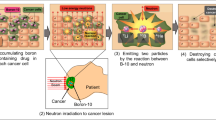Abstract
To have access to an appropriate neutron source is one of the most demanding requirements for neutron studies. This is important specially in laboratory and clinical applications, which need more compact and accessible sources. The most known neutron sources are fission reactors and natural isotopes, but there is an increasing interest for using accelerator based neutron sources because of their advantages. In this paper, we shall present a photo–neutron source prototype which is designed and fabricated to be used for different neutron researches including in-laboratory neutron activation analysis and neutron imaging, and also preliminary studies in boron neutron capture therapy (BNCT). Series of experimental tests were conducted to examine the intensity and quality of the neutron field produced by this source. Monte–Carlo simulations were also utilized to provide more detailed evaluation of the neutron spectrum, and determine the accuracy of the experiments. The experiments demonstrated a thermal neutron flux in the order of 107 (n/cm2.s), while simulations affirmed this flux and showed a neutron spectrum with a sharp peak at thermal energy region. According to the results, about 60 % of produced neutrons are in the range of thermal to epithermal neutrons.




Similar content being viewed by others
References
IAEA-TECDOC-1065 (1999) Production technologies for Molybdenum-99 and Technetium-99 m, ISSN 1011–289
IAEA-TECDOC-1604 (2008) Neutron imaging: a non-destructive tool for materials testing, ISSN 1011–4289
IAEA-TECDOC-1223 (2001) Current status of neutron capture therapy, ISSN 1011–4289
IAEA-TECDOC-1153 (2000) Use of accelerator based neutron sources, ISSN 1011–4289
Blue TE, Yanch JC (2003) Accelerator-based epithermal neutron sources for boron neutron capture therapy of brain tumors. J Neurooncol 62:19–31
Ma A, Awotwi-Pratt J, Alghamdi A, Alfuraih A et al (2007) Monte Carlo study of photoneutron production in the Varian Clinac 2100C linac. J Radioanal Nucl Chem 276(1):119–123
Xu Y, Randers-Pehrson G, Marino SA, Bigelow AW et al (2011) An accelerator-based neutron microbeam system for studies of radiation effects. Radiat Prot Dosim 145(4):373–376
Auditore A, Barna RC, De Pasquale D, Italiano A et al (2005) Study of a 5 MeV electron linac based neutron source. Nucl Instr Methods Phys Res Sect B 229:137–143
Bevilacqua R, Giannini G, Calligaris F, Fontanarosa D et al (2007) PhoNeS: a novel approach to BNCT with conventional radiotherapy accelerators. Nucl Instr Methods Phys Res A 572:231–232
Durisi E, Alikaniotis K, Borla O, Bragato F et al (2015) Design and simulation of an optimized e-linac based neutron source for BNCT research. Appl Radiat Isot 106:63–67
Zarma SF, Mirea DA, Busca I, Porschianu MN et al (2014) Implementing BNCT through the use of an electron accelerator. Rom Rep Phys 66(1):182–191
Pazirandeh A, Torkamani A, Taheri A (2011) Design and simulation of a neutron source based on an electron linear accelerator for BNCT of skin melanoma. Appl Radiat Isot 69:749–755
Photo-Nuclear Cross sections. http://www.nndc.bnl.gov/sigma/. Accessed 14 June 2010
Goodarzi S (2010) Investigation on B-10 Distribution in Rat’s brain and Modeling of Boron Distribution Determination Method. Dissertation, Tehran Science and Research Branch of Islamic Azad University
Ferrari A, Sala PR, Fasso A, Ranft J (2005) FLUKA: a multi-particle transport code, CERN-2005–10, INFN/TC 05/11, SLAC-R-773
Author information
Authors and Affiliations
Corresponding author
Rights and permissions
About this article
Cite this article
Taheri, A., Pazirandeh, A. Measurements of the thermal neutron flux for an accelerator-based photoneutron source. Australas Phys Eng Sci Med 39, 857–862 (2016). https://doi.org/10.1007/s13246-016-0477-3
Received:
Accepted:
Published:
Issue Date:
DOI: https://doi.org/10.1007/s13246-016-0477-3




